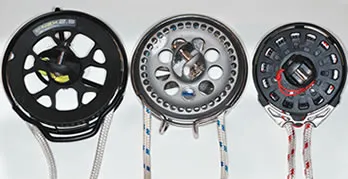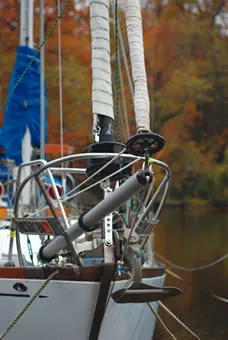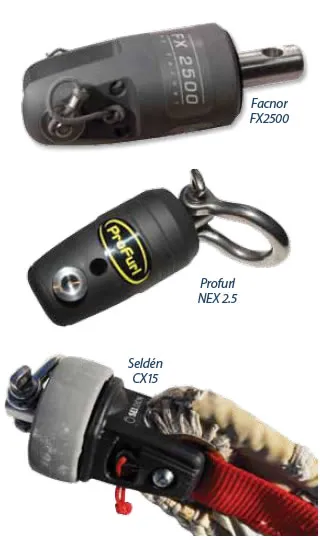
Photos by Ralph Naranjo
Flying-sail furlers are far more than a marketing fad, and if youre a cruiser, daysailor, or point-to-point racer who sails shorthanded, these headsail furling systems can make light-air sails as user-friendly as the trusty old genoa thats wound up on the headstay.
These endless-line or code furlers comprise a head swivel, a spliced-together endless furling-control line, and a rotating spool that houses the control line. Designed for use with lightweight, asymmetrical, and code sails, these foil-less furlers can help optimize a boats horsepower when the breeze drops below 10 knots, especially if the apparent wind angle is in the 50- to 110-degree range. With the sails head shackled to the furler swivel and the tack attached to the sprit-mounted spool, a pull on the endless furling line causes the spool to rotate, inducing a twist that is transferred from the tack to the head.
Practical Sailor last reviewed endless-line furlers in the March 2008 issue. In that test, the Facnor FX2500 nosed out systems from Bamar (PS Recommended), CDI, Colligo, Karver, and Harken, and a drum coiling unit from Schaefer (Budget Buy). The FX2500 has remained our favorite and is the benchmark by which we measured the performance of new units from Profurl and Seldn for this test.
We put Profurls new NEX 2.5 and Seldns CX15-which were released after the 2008 test-through close scrutiny and sea trials. A reefing gear and furling systems manufacturer for nearly 30 years, Profurl is part of the France-based Wichard group of companies. Seldn Mast Inc. is another European furling gear maker with facilities in the U.S.
We compared the newcomers performances to the Facnor continuous-line furler, which weve been long-term testing since the 2008 evaluation when it was named Best Choice. Facnor, like Profurl, is based in France and has more than three decades of experience manufacturing furling systems.

Photos by Ralph Naranjo
How We Tested
Initially, we assumed that this would be a simple furl/unfurl test, but we soon discovered that secondary issues like how well the tack and head hardware functioned and the importance of a fair lead for the furling line were also critical variables. All test units were subjected to a wide range of conditions, but we approached the test with the assumption that these setups were meant for light-air sailing, not a walk on the wild side.
Nevertheless, testers did push the envelope a bit and found that even in off-the-wind, 20-knot conditions, furling is possible, but the loads on unstayed sprits can be substantial and waiting too long to retire light-air sails can create problems. We also noted that halyard tension plays a key role in the furling systems function: Having too loose of a leading edge causes excessive luff sag and too much made bearings harder to spin.
For testing, we converted a 650-square-foot, hank-on, radial-clewed, 2-ounce Dacron drifter/reacher into a furling sail by sewing on a length of heavy-duty, 1-inch polyester webbing. It ran the full length of the luff and handled both the tension load and torque associated with furling.
To gauge a furlers performance, testers would unfurl the sails, then bear off to about a 120- to 130-degree reach, and with the mainsail blanketing the drifter, they would ease the sheet and haul away on the furlers endless line. A simple spring scale measured the initial tension it took to start the process, and testers found that-as might be expected-the furling line load decreased as the sail area diminished.
Evaluators were split on whether to terminate the big loop on the foredeck or lead it all the way back to the cockpit. The latter requires careful use of lead blocks and a bungee cord tensioner at the end of the loop. The former lets a crew work near the mast with a full view of the furling sail and an ability to make the best use of boat motion. After testing the furlers at both locations-with the furling line near the mast setup and then from the cockpit-the test crew reported that the mast location was preferable.
Testers evaluated the furlers hauling ease, attachment efficiency, and construction quality, and also compared their prices and warranties in the final ratings.
The Test Setup
Our test platform was PS Technical Editor Ralph Naranjos classic Ericson 41, Wind Shadow, a light-air efficient, double-headsail sloop with an 18,000-pound displacement. In true cutter-like tradition, the boat was sailed for decades with piston-hank sails before making the transition to roller furling. For furler tests, Naranjo installed a Seldn gennaker bowsprit, which comes kitted with all the fittings for an easy-to-set temporary bowsprit. (The Seldn sprit kit was tapped as the PS Best Choice over similar products from Forespar, Forte, and Sparcraft in the June 2008 issue.) Testers needed to extend the sprit a few inches beyond Seldns specs listed for unsupported length, so we had to add a removable bobstay to the equation as a precaution.
Alloy and carbon tube sections are immensely strong in compression, but when used in an unstayed context, the load becomes more of an example of a lever and fulcrum. The stress riser or hotspot becomes the first bale that the pole goes through on its way aft, and the sails upward crimping force increases as the apparent wind moves forward. In order to counter this load, we turned the central-axis gennaker control line into a removable Dyneema bobstay. The upward tension of the sail was offset, and the bending moment tormenting the unsupported sprit was turned into a more manageable compression load. This extra complication isn’t necessary if the unsupported sprit segment is kept short; however, the bobstay addition allowed testers to project the tack farther forward and sail a bit higher in light air.
Profurl Nex 2.5
Profurls continuous-line furler, the NEX 2.5, is indeed a well-engineered, efficient, and easy-to-operate furler. Sized just a bit larger than the Facnor FX2500 furler, the Profurl hauled in the 650-square-foot drifter/reacher with similar ease. The NEX 2.5s 5 7/8-inch spool diameter makes the unit as efficient as the Facnor and just as tight-gripping. Profurl uses an S-grip pattern in the spool groove to keep the spliced control line from slipping or binding.
Just for fun, testers furled the test sail a few times with the wind forward of the beam and found that the large-diameter spool delivered plenty of torque to get things rolling. The line operated smoothly in tests, never slipping, even when there was slack on the returning line.
Both the control-line spool and the head swivel run on a no-maintenance, sealed bearing cassette. The alloy housings are rugged and well-reinforced, but at the same time, theyre designed to be as light as possible.
To accommodate the needs of offshore sailors, Profurl made the furlers head snap-shackle operation and tack-pin removal as one-hand-executable as possible. The companys I-connect pin-latch system used to attached the sail tack is quick, ergonomic, reliable, and repairable. The approach to threading the spliced, looped furling line onto the spool is efficient, and no parts need to be removed in the process.
When it comes to load-bearing metal components, manufacturers have to find a balance between acceptable corrosion resistance and tensile strength. Typically, the stronger stainless grades are less corrosion resistant.
The Profurl NEX 2.5, manufactured from 6061 machined aluminum, uses a 17-4ph stainless Wichard snap shackle in the lower end and 316 stainless for the tack pin. The snap shackles metal is equivalent to 304 stainless, which is harder and stronger than 316, but has less nickel content and is very magnetic. Over the years, we have seen a direct correlation between corrosion resistance and high-nickel content, non-magnetic alloys.
Bottom line: An efficient, well-engineered continuous-line furler, the Profurl NEX 2.5 gets PSs Recommendation.

Facnor fx2500
The initial enthusiasm we had about the Facnor FX2500 in the 2008 test hasn’t waned a bit. During our long-term test of the furler (ongoing for more than two years), we discovered that the terms reliable and corrosion resistant should be added to the original list of accolades we gave the furler.
An unintentional submersion test of the furling spool proved that the bearing cassette features a very tight seal. For several weeks, the spool was stored in a plastic bucket deep in the test boats locker, where a faulty hatch gasket allowed water to partially fill the bucket. Despite its extended dunking, the Facnors furling spool spun freely during tests and continued to perform as well as ever. Its worth noting that Facnor uses non-magnetic 316 stainless in the FX2500s construction, and the immersion test is testament to its corrosion resistance.
The Facnor unit is about the same size as the Profurl, a tad bit lighter, and equally easy for the foredeck crew to handle. Adding and removing the long, spliced furling loop involves a simple tuck and turn around the spool, and the clevis pin releases are the most one-hand friendly of all the units tested. The stainless steel outer ring and frame weldment holds up well over time, and the efficient alloy spool with a functional line-gripping V shaped groove is light and smooth handling under load.
Bottom line: The Facnor FX2500 takes a sousing and keeps on spinning. It maintains its place at the head of the continuous-line furlers pack.
Seldn cx15
Since we last tested endless-line furlers, Seldn introduced three new products in its Code X line of gennaker-handling gear. For this test, we evaluated the CX15, the smallest unit in the series. It is rated for sail areas up to 861 square feet and has a max working load of 3,360 pounds-well over what our 650-square-foot drifter/reacher would generate in light- to medium-air scenarios.
The CX15 furler spool is considerably smaller than the other two units in this test, naturally requiring more pull to generate the same amount of torque. Despite this apparent reduction in furling power, the unit easily coped with the requirements at hand. One of the reasons the lesser torque sufficed in testing was that we tended to sail a course for optimum furling. In a racing situation, where a diversion from the heading to the mark is the last thing a helmsman wants to do, it might be worth upsizing to Seldns CX25 unit ($1,450), which is closer in physical size to the Profurl NEX 2.5 and Facnor FX2500 furlers.
The CX15 is a ruggedly built, compact unit that comes with a variation on the tuck-and-twist around the spool approach to loading the continuous loop furling line. The line stripper pops out of the spool to allow users to easily insert or remove the furling line. The line stripper and spring-loaded clevis pins are tethered with knotted pieces of small line, preventing them from inadvertently going over the side.
Seldns engineers have come up with a handy, double cam cleat, tandem furler control that makes line-handling-especially securing the furled sail-much easier. The CX15s furling spool is made of glass fiber-filled polyamide composite. Its hardware is duplex stainless steel, which is stronger than 316 but also is highly magnetic.
Bottom Line: Unique features, a five-year warranty, and an affordable price earn the capable and compact CX15 the PS Budget Buy.
Conclusion
If improving your boats light-air performance is a priority-and you don’t have a couple of teenagers on board or a hyperactive sailing partner-a foil-less furler could be the ideal solution. The rolled-up sail is set and doused with neither drama nor taxing gymnastics.
All three of the test units met their mark and came away with respectable ratings. The Profurl NEX 2.5 is chasing at the heels of our favorite, the Facnor 2500, which maintains its lead after two years of long-term testing. Seldns CX15 handled the job at hand and then some. For cruisers looking for a capable Budget Buy, Seldns compact unit and alloy sprit kit have a lot to offer. These furlers are a step ahead of those products we tested in the first go round.
With the boost in light-air sail-handling comes a savings in fuel, more fun under sail, and a big decrease in the likelihood of having to wrestle with an out-of-control foredeck fire-drill.



































